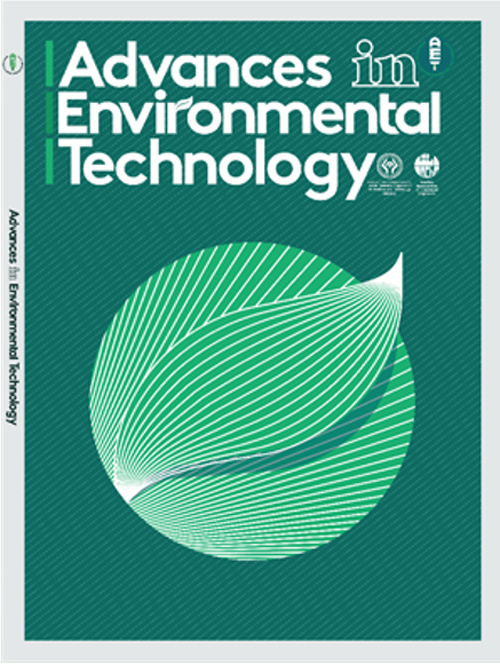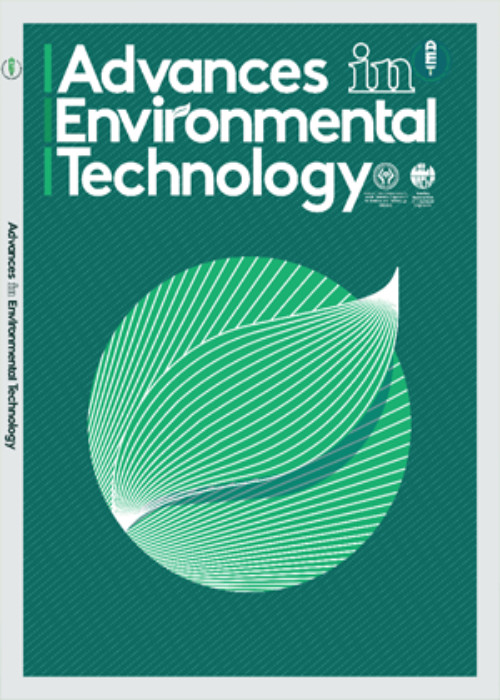فهرست مطالب

Advances in Environmental Technology
Volume:7 Issue: 1, Winter 2021
- تاریخ انتشار: 1400/09/14
- تعداد عناوین: 6
-
-
Pages 1-10The objective of this study was to investigate the sources of tropospheric ozone (O3) precursors in an urban area using principal component analysis. Chemically reactive conventional pollutants such as carbon monoxide (CO), carbon dioxide (CO2), nitric oxide (NO), and nitrogen dioxide (NO2), as well as some selected meteorological parameters such as global solar radiation (SR), air temperature (AT), relative humidity (RH), wind speed (WS), and wind direction (WD), were incorporated in this analysis. Real-time observation data were obtained from two monitoring stations, Limbayat and Varachha, situated in Surat city, India. The occurrence of a peak O3 level in the summer at 5 p.m. proved the well-known fact of interconnection among the temperature, solar radiation, and increment in O3 concentration. The potencies of CO and NOwere remarkable in either the first or second principal component (PC) observed at both locations with more than 45% concentration, which alluded that the main source of O3 was urban transportation and AT contributed with 50% weightage in the PC ascertained key role of photolysis process in the O3 formation.Keywords: Principal Component Analysis, Surat, Tropospheric ozone, Urban transportation
-
Pages 11-17Climate change includes global warming driven by human-induced emissions of greenhouse gases and the resulting large-scale shifts in weather patterns. Tehran, Iran, has a population of 13 million (2017) and produces about 13,000 tons of municipal solid waste per day and 4.7 million tons annually. This study used the life cycle assessment (LCA) method to calculate all the emissions in different scenarios for Tehran's waste management. The IWM model was used for Phase II of the LCA. The results of the proposed scenarios showed that the highest emission was from greenhouse gases (GHG), which were9.6, 3.2, and 2.7 million tons in the first, second, and third scenarios, respectively. The IPCC reports and the results from the life cycle inventories were used to calculate the social cost analysis for the scenarios based on the CO2 equivalents. The third scenario caused a 71.8% and 17.2% reduction in terms of social costs compared to the first and second scenarios, respectively. Thus, according to the importance of greenhouse gases in global warming, employing a third scenario in the waste management system could effectively reduce greenhouse gases in Tehran.Keywords: Life Cycle Inventory, Scenario, waste management, Greenhouse gas, Tehran city
-
Pages 19-27
Today, because of expansion in oil costs, restricted petroleum product assets, ecological thought and an unnatural weather change, the ethanol fills have been centered around elective powers. The use of ethanol is more effective in compression ignition (CI) engines because it is about 30 percent more effective than in spark-ignition (SI) engines due to increased combustion efficiency. The use of ethanol in low heat rejection (LHR) engines helps raise the temperature of the combustion chamber, creating a heat barrier around it. The effect of coating the cylinder head, pistons, and valves of a diesel engine with the molybdenum (Mo) and Al2O3+TiO2 is investigated in this work. As a result, the coated pieces of the combustion chamber were accommodated by a heated boundary. The coated and uncoated engines were evaluated under similar engine operating conditions. The CO, HC, and smoke emissions were reduced, but NOx emissions slightly increased for the Al2O3+TiO2 coated engine. As a result, it has the most beneficial environmental effects. (VOCs). PM2.5 showed a positive correlation with PM10 (R2=0.84), indicating that both PM2.5 and PM10 were produced from similar pathways of fossil fuel combustion by automobiles and industrial activities. Further, the air quality index (AQI) analysis showed unhealthy atmospheric conditions throughout the year for city dwellers around the study area.
Keywords: Molybdenum (Mo), Al2O3+TiO2, low heat rejection engines, surface ignition, glow plug -
Pages 29-36One of the methods to control the rain on the spot and reuse it is the green roof. This method uses a multi-layer system of vegetation on the roof and balcony of a building to absorb part of the rainwater; the volume and peak runoff are also reduced by evaporation, transpiration, and treatment processes. This research was conducted as a field experiment in the hydraulic laboratory of the Agriculture Faculty in the University of Zanjan, Iran. The factors of the study design included a green roof covered with shards of brick and cultivated soil (grass). The experiments were performed at rainfall intensities of 45, 55, and 65 mm/h with 5, 10, and 25 year return periods, respectively. Also, the volume of the water stored and drainage was measured in different conditions. The results of this study showed that regardless of the type of materials used in the green roof, with increasing time, the amount of water stored in the green roof decreased, and the amount of drained water increased. A comparison of the average performance of the brick and grass modifiers for green roofs showed that the volume of the stored water in the grass corrector was higher; if the shards of bricks were used, 69% of the rainfall would be stored, and 31% was drained. However, adding grass to the green roof increased the volume of stored water to 78% and reduced the volume of drainage water to 22%. Also, the presence of grass on the green roof reduced the electrical conductivity by 32% compared to the single brick.Keywords: green roof, drainage water, storage water volume, grass, rainfall intensity
-
Pages 37-46Constructed wetlands are extensively employed to treat wastewater in many countries and are an eco-friendly and low-cost wastewater treatment technique. In this study, the performance of an intermittently operated vertical subsurface flow constructed wetland planted with Amaranthus dubius and the effect of adding oyster shells as a substrate layer in the wetland on its performance were investigated. Major quality parameters such as phosphates, ammonia nitrogen, nitrite nitrogen, nitrate nitrogen, Total Organic Carbon and COD in the effluent and influent were monitored and compared. The concentration of these quality parameters was determined by the colorimetric method in the laboratory using a UV-Visible spectrophotometer. The results indicated that the planted vertical subsurface flow constructed wetlands achieved efficient removal of ammonia nitrogen from the wastewater and were effective for nitrification. The addition of oyster shells in the substrate enhanced the total nitrogen removal from the wastewater. The ability of the HYDRUS CW2D model in simulating reactive transport through a vertical subsurface flow constructed wetland was also investigated. A good match between the measured and simulated parameters could be achieved after adjusting certain constructed wetland parameters in the HYDRUS CW2D model. Model validation was performed based on a quantitative statistic known as the ratio of root mean square error (RMSE) to the standard deviation of the observed data - . The value for ammonia nitrogen and nitrate nitrogen was less than 0.70, which is satisfactory.Keywords: Constructed wetlands, Nutrient removal, Wastewater treatment, Water use, HYDRUS CW2D
-
Pages 47-56In this study, a novel hollow fiber membrane contactor (HFMC) under a non-wet condition was numerically explored by CFD techniques based on the finite element method to capture CO2 from the CH4/CO2 gas mixture. A new design, such as a shell and tube heat exchanger with baffles, was proposed. The MEA, DEA, and TEA, as different amines solutions, were selected as the liquid solvents. A CO2-containing gas mixture and amine solution were passed in the shell side and the tube side of the membrane contactor, respectively. The simulation findings indicated a good agreement with the reported experimental data demonstrating that such a model would evaluate the effects of different parameters during the HFMC system. Specifically, the results showed that the baffles' presence improved the separation efficiency due to the increased residence time on the shell side. The results also indicated that the MEA solution had the highest CO2 absorption. In the new design (shell and tube heat exchanger with baffles), the rising solvent inlet velocity, decreasing gas velocity, and counter-current flow pattern positively affected separation efficiency.Keywords: HFMC, CO2 capture, Shell, Tube, Baffles, computational fluid dynamics


